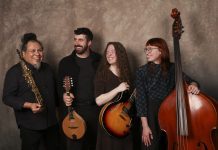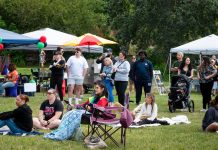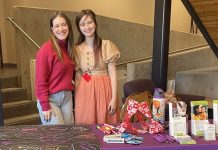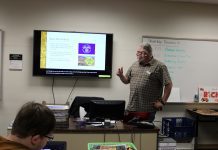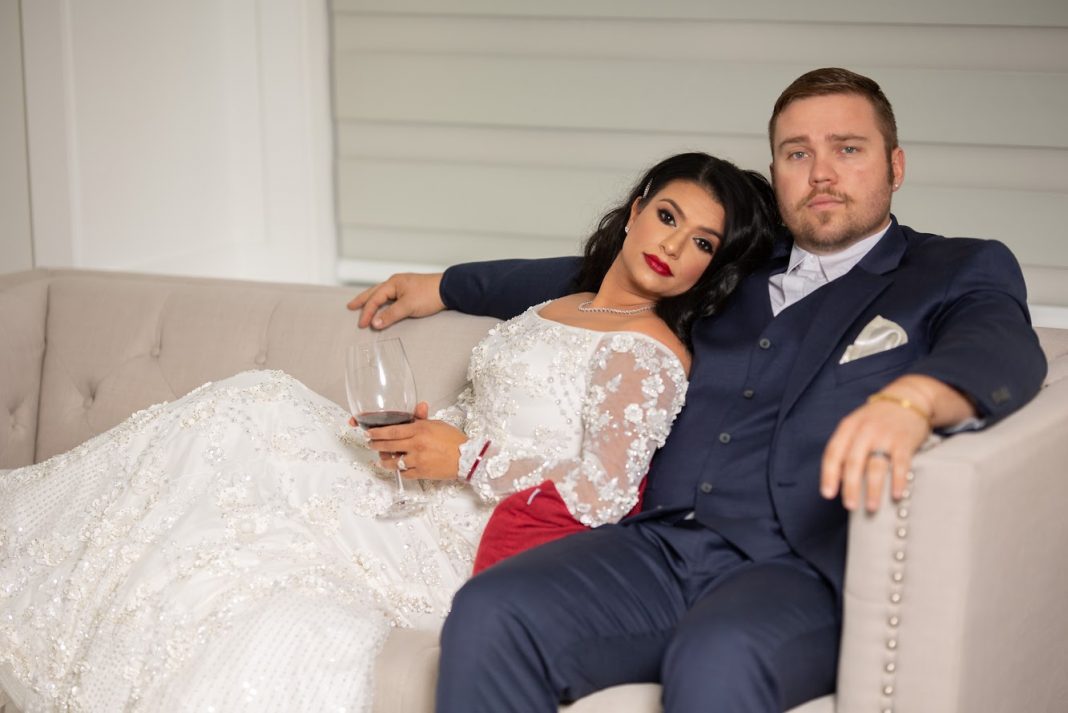I recently attended an Anand Karaj, a Sikh marriage ceremony meaning “Blessed Union,” in Guru Nanak Gursikh Temple in Lynden. This was my first visit to this temple, and I had never been to a wedding outside of western culture. It was a wonderful experience, filled with traditional ceremonies, delicious food, and lots of celebration.
The bride, Sandi Atwal, was born in India, grew up in the Sikh faith, and her family’s first language is Punjabi. In contrast, the groom, Henry Petersen, had only attended western culture weddings before he proposed to Sandi. But he was intent on having a traditional Indian wedding in the Sikh Temple to honor Sandi’s Indian family.
When a couple is to be married in the Sikh Prayer Hall, the religious leader sets the date for the wedding. Family members and friends of the bride’s family receive their wedding invitation along with a box of sweet treats that include ladoos. A ladoo is a delicious, mouth-watering pastry made with chickpeas and coconut, which signifies a life event like a wedding or birth announcement. “If you have something sweet, you’ll remember,” Sandi told me.

Early Friday morning, the week before the wedding, the priest arrived at Sandi’s parents’ home. For the next three days, he read the entire Holy Book. Every person that came into the home that weekend was blessed as part of the preparation for the wedding.
A few days later, the Mayian ceremony took place (often referred to as “Maa’nyo’n”). This evening festival was the time they practiced many rites, including the Rangoli (or what some call, Chaook). A design is drawn using dried rice flour (or other forms of colored powder) to feel strength and generosity as well as to bring good luck.

Another ritual, called the Batna, was performed, where friends and family rub turmeric paste on the arms and legs of the bride to cleanse and bless her. The bride sits below a red-colored scarf held by her sisters during this ritual. Sandi wore the scarf for the rest of the night, to signify that she was the bride.
A Choora ritual also occurred during the party, where the bride’s mother and brothers placed bracelets on Sandi’s wrist. The bracelets were dipped in milk for good luck. Then Sandi tied bracelets onto the guests and arranged for someone to decorate all of the women with henna (mehndi) tattoos to adorn them in honor and celebration of the wedding.
Before the evening erupted into an epic dance party, they participated in the Jaggo ceremony. This includes banging sticks on the ground, a tradition that comes from trying to get people to wake up. In the “old days” people would go around town singing rhymes and dancing. Her sisters did the traditional Giddha folk song of women’s lives. The party went on for hours.
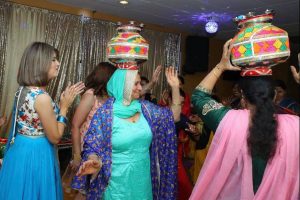
To be dressed appropriately for the formal Indian ceremony at the prayer hall, Sandi had assured me that nice pants and a top would be appropriate attire for western women, because all guests were seated on the floor in the prayer hall. Many non-Indian guests wore traditional outfits, which is apparently not an easy thing to do if you aren’t used to it. Women’s heads were covered in scarves. White was an acceptable color for guests, as traditional bridal colors are red, pink, and yellow.
We arrived to a morning meal of sweets and teas. The initial event on the schedule was The Baraat, the Groom’s Procession. The families formally greet each other with hugs and gifting of garlands of flowers in anticipation of the uniting of the families. “There may not have been a ton of actual dialogue exchanged,” says Henry, “but everyone understood this was a happy day. It made me really happy.”
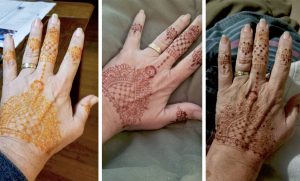
We all removed our shoes before we filed into the prayer hall and were seated on the floor. Women were seated on the left, men on the right. Sandi was escorted in by her parents and joined Henry in front of the room. “It was my favorite moment. When I saw her, so beautiful, and she sat down next to me,” Henry gushed.
The ceremony consisted of songs and prayers in Punjabi, which were translated into English on a screen in the front of the room. The last part of the ceremony was the Laavan, the rite of passage when the couple slowly walks around the Holy Book four times, with Sandi’s brothers and male protectors escorting her as prayers are recited. With each revolution, the couple commits to be together in mind, body, and soul.
The end of this ritual marks the completion of the ceremony. It’s not appropriate for the couple to touch while in the prayer hall; there was not even a kiss. Henry and Sandi knew this, and were quite careful to not touch. Even the priest teased them a little bit. “You can get closer,” he said when Henry came and sat down an arm’s length from Sandi. Sandi was so happy when she sat down, she shook Henry’s hand. “I sealed the deal!” she says with a giant grin.

All guests were offered karah prashad as the ceremony concluded, a sweet dish made from flour, sugar, and butter, symbolizing the spirit of love and sharing. Afterwards all guests were able to greet the new couple outside the prayer hall and offer love and congratulations, and then the festivities moved to a nearby reception space where the bride and groom changed into traditional western cultural attire.
Did I mention the food? I mean, the feasts? The entire wedding day was catered by Bellingham’s Naan and Brew.
After the wedding, Sandi and Henry participated in a Doli. An emotional time for Sandi’s mom, this marks the formal departure of the bride from her parental house.
Since the wedding, Sandi has embraced being from India more strongly. “It’s been a teaching moment for Henry,” she says. “And I want to make sure we don’t forget my culture.”




